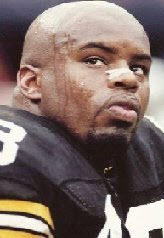Giving Back: A Leadership Lesson From Oliver Gibson

I had the great opportunity of listening to Oliver Gibson last month at a Hall of Fame induction in Joliet. He was a football player at local Romeoville High School. He went on the star at Notre Dame and had a nine-year playing career in the NFL, including a Super Bowl appearance with the Steelers.
Oliver’s presentation was outstanding. He thanked his mother and father for all their encouragement and support and said how appreciative he was of his older sister whom he emulated both on the playing field and in the classroom. He told us how proud he was to come from the Joliet area because of the athletic reputation of our area. He then went on to say how fortunate he was to play for the coaches at Romeoville High School.
Toward the end of his presentation, he informed us that he accepted the head coaching position for the football program at Romeoville.
He said he was so pleased to accept this position because he now can give back all he received from his coaches. He is honored to have the opportunity to influence kids the way his coaches did for him.
Having coached for 44 years, I thought how blessed the players at Romeoville are to have a man like Oliver leading them because he really gets it. I don’t know if I can define and articulate “it,” but as my dear friend and fellow coach, Jack Hermanski, says, “I know ‘it’ when I see it.” And I saw it in Oliver last night.
Is this a good attitude for leaders to emulate when they accept their leadership positions? Is embracing leadership as an opportunity to give back a good way to look at it?
I believe the answer to the above questions is a definite “yes.” I think we all have been fortunate to have mentors along the way who helped us achieve in our chosen professions. They did not tell us how a leader should lead; instead, they showed us and they showed us on a consistent basis.
One of the concepts I took from the book, “From Good to Great,” was the friendship leaders in companies had with their team members when they retired. This seemed to be the case because when they were working together, the team knew how much the leaders cared for them beyond the narrow confines of a workplace.
Oliver is going into his leadership position looking to give back to the kids he will be coaching. I believe because of his attitude that when he finishes his coaching career, he will have many life-long friends from the players he coaches because he is entering the profession from a great foundation – to give back.
-Pat










